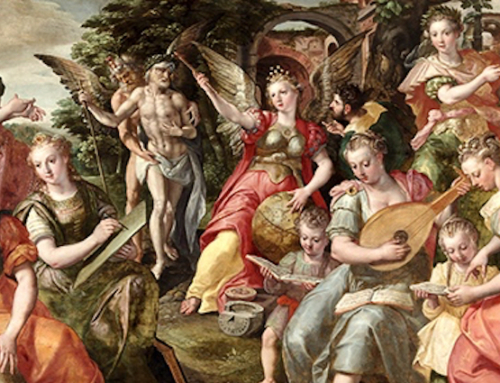Secular relativists and Europhobes in academics say that based on entirely subjective criteria, a Eurocentric culture collectively decided that certain art was great and cruelly imposed that view on other peoples through “culture imperialism.” But is it really true that people in the West twisted arms and forced people to like Western art and music?
 Of the so-called three Transcendentals—Goodness, Beauty, and Truth—I have struggled most to nail down “truth” in strictly artistic terms. How exactly can we say that a certain painting or musical composition exhibits truth? If the painting or song lyrics depict a particular scene, that scene itself is easier to judge as true or false, but I’m talking about the technique of the painting and about instrumental music with no lyrics. Can certain kinds of brush strokes or chords be “true”?
Of the so-called three Transcendentals—Goodness, Beauty, and Truth—I have struggled most to nail down “truth” in strictly artistic terms. How exactly can we say that a certain painting or musical composition exhibits truth? If the painting or song lyrics depict a particular scene, that scene itself is easier to judge as true or false, but I’m talking about the technique of the painting and about instrumental music with no lyrics. Can certain kinds of brush strokes or chords be “true”?
I have young faculty colleagues at the university, secular relativists and Europhobes, who teach students and write books and articles proclaiming as absolute truth that there is no absolute truth. Specifically, they say there is absolutely no “intrinsic greatness” in Western music. They say that based on entirely subjective criteria, a Eurocentric culture collectively decided that certain art was great and cruelly imposed that view on other peoples through “cultural imperialism.” Of course, they find it absolutely true that cultural imperialism itself is a vice, perhaps based on the absolutely true virtue (for most young people, as any parent can attest) of “fairness” (never mind the other seven virtues; those are Eurocentric), the absolute truth of identity politics, and on the absolute truth of emotional rather than factual judgment in determining what criteria constitute the victimization they decry.
It seems almost “unfair” (sorry!) of me to point out all the obvious contradictions and flaws in such a philosophical house of cards. In class, I have simply resorted to projecting pages of the conductor’s score of great musical works on the screen and showing students the intrinsic structure and coherent syntax of the musical form, harmonic framework, counterpoint, and orchestration, which together point to something like a great skyscraper of musical architecture. These things speak for themselves of music’s intrinsic integrity of structure, if not specifically of beauty. A skyscraper is “true,” in part, simply because it requires a marvel of engineering for it to not topple over, and this is due to the truth of the force of gravity. We also have the evidence of such integrity as a form of “truth” based upon other elements of nature. If things exist, and if it is “true” that they do, like a leaf on a tree that remains alive, we can observe that the leaf has a clearly coherent biological structure of intrinsic symmetrical design and balance, flowing sap due to water pressure, a system of photosynthesis, and so on. Music that exhibits analogous systems of structure and internally interdependent components can be said to reflect this kind of ontological truth. If such music were a building, it would stand, and if it were a leaf, it would remain green and alive.
However, the real issue for these academics (apart from publishing some kind of clever idea in order to gain tenure and a professional reputation for saying something groundbreaking, given that they don’t produce any art or music themselves) is the issue of “cultural imperialism.” Is it really true that people in the West twisted arms and forced people to like Western art and music? To my knowledge, everyone on earth agrees that the sunset is beautiful. As a matter of natural law, all humans are apparently wired to recognize that the sunset is beautiful, to the disappointment of relativists everywhere, because it is. Eurocentric imperialists did not cruelly force the idea that the sunset is beautiful on other cultures!
Likewise, there are many other things with intrinsic properties that people of all cultures innately appreciate, whether they invented those things or not. Pizza and hamburgers can be found in cities worldwide with very diverse cultures. Did someone cruelly force those people to acquire a taste for those foods, or did those people fall in love with pizza on their own? (No one forced me to love curry and sushi, likewise.) There are many symphony orchestras in Asia who play the music of Beethoven, entirely and only because the musicians truly love it, and so do their audiences. They would be the first to deny that anyone coerced them to love it. They love it because of its intrinsic value and indeed, its universally appealing human truth, just as everyone loves a good sunset. So, the crucial argument of victimization by insensitive Europeans in these cases is simply not accurate; therefore, their argument of so-called cultural imperialism crumbles like a house of cards. If anything, it is impressionable young students who are being victimized by being taught to hate their own culture.
I’m not saying there can be no such thing as cultural imperialism. Americans have tried, for example, to tie humanitarian aid to impoverished nations to imposed abortion and birth control, and some of those people themselves have called that cultural imperialism, because it is being forced upon them against their will. I don’t see these Europhobic academics complaining about those Western values being coercively imposed on others, though.
Finally, truth, goodness, and beauty are not exclusive to European culture, by any means, and can be found in many cultures. In my thirty-year career in music and academe, I have never found any of these imaginary villains who claim that all truth, goodness, and beauty in music are only found in the West. This, too, is a straw-man argument.
The Imaginative Conservative applies the principle of appreciation to the discussion of culture and politics as we approach dialogue with magnanimity rather than with mere civility. Will you help us remain a refreshing oasis in the increasingly contentious arena of modern discourse? Please consider donating now.
The featured image is a detail from Painting and Music (Portrait of the Artist’s Son) (1800) by Martin Drolling (1752–1817) and is in the public domain, courtesy of Wikimedia Commons. It has been brightened for clarity.







Beautiful logic in the face of false charges of “cultural imperialism”. Thank you for this. i am sharing it with all my friends and I am immediately going to purchase “The Sea Knows”.